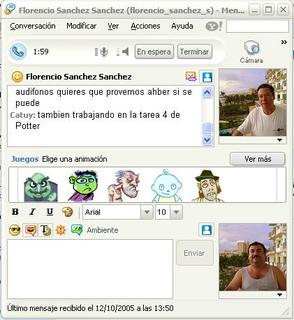
Assessment in a constructivist learning environment. [On-line]
http://www.coe.missouri.edu:80tiger.coe.missouri.edu/Bednar, A.K., Cunningham, D., Duffy, T.M., Perry, J.P. (1995). Theory into practice: How do we link? In G.J. Anglin (Ed.), Instructional technology: Past, present and future. (2nd ed., pp. 100-111)., Englewood, CO: Libraries Unlimited, Inc.
Behaviorism and constructivism. [On-line]. Available:
http://hagar.up.ac.za/catts/learner/debbie/CADVANT.HTMBehaviorism. [On-line]. Available:
http://sacam.oren.ortn.edu/~ssganapa/disc/behave.htmlBeyond constructivism - contextualism. [On-line]. Available:
http://tiger.coe.missouri.edu/~t377/cx_intro.htmlBlack, E. (1995). Behaviorism as a learning theory. [On-line]. Available:
http://129.7.160.115/inst5931/Behaviorism.htmlBracy, B. (Undated) Emergent learning technologies. [On-line]. Available:
gopher://unix5.nysed.gov/00/TelecommInfo/Reading%20Room%20Points%20ViewBurney, J. D. (Undated). Behaviorism and B. F. Skinner. [On-line]. Available:
http://www2.una.edu/education/Skinner.htmConditions of learning (R. Gagne). [On-line]. Available:
http://www.gwu.edu/~tip/gagne.htmlConstructivist theory (J. Bruner). [On-line]. Available:
http://www.gwu.edu/~tip/bruner.htmlCunningham, D. J. (1991). Assessing constructions and constructing assessments: A dialogue. Educational Technology, May, 13-17.
Davidson, K. (1998). Education in the internet--linking theory to reality. [On-line]. Available:
http://www.oise.on.ca/~kdavidson/cons.htmlDembo, M. H. (1994). Applying educational psychology (5th ed.). White Plains, NY: Longman Publishing Group.
Dick, W. (1991). An instructional designer's view of constructivism. Educational Technology, May, 41-44.
Dorin, H., Demmin, P. E., Gabel, D. (1990). Chemistry: The study of matter. (3rd ed.). Englewood Cliffs, NJ: Prentice Hall, Inc.
Duffy, T. M., Jonassen, D. H. (1991). Constructivism: New implications for instructional technolgy? Educational Technology, May, 7-12.
Ertmer, P. A., Newby, T. J. (1993). Behaviorism, cognitivism, constructivism: Comparing critical features from an instructional design perspective. Performance Improvement Quarterly, 6 (4), 50-70.
Genetic epistemology (J.Piaget). [On-line]. Available:
http://www.gwu.edu/~tip/piaget.htmlGood, T. L., Brophy, J. E. (1990). Educational psychology: A realistic approach. (4th ed.).White Plains, NY: Longman
Information processing theory and instructional technology. [On-line]. Available:
http://tiger.coe.missouri.edu/~t377/IPTools.htmlInformation process theory of learning. [On-line]. Available:
http://tiger.coe.missouri.edu/~t377/IPTheorists.htmlJonassen, D. H. (1991) Objectivism versus constructivism: do we need a new philosophical paradigm? Educational Technology Research and Development, 39 (3), 5-14.
Jonasson, D.H. (Undated). Thinking technology: Toward a constructivist design model. [On-line]. Available:
http://ouray.cudenver.edu/~slsanfor/cnstdm.txtJonassen, D. H., McAleese, T.M.R. (Undated). A Manifesto for a constructivist approach to technology in higher education. [On-line].
Available:http://led.gcal.ac.uk/clti/papers/TMPaper11.htmlKhalsa, G. (Undated). Constructivism. [On-line]. Available:
http://www.gwu.edu/~etl/khalsa.htmlKulikowski, S. (Undated). The constructivist tool bar. [On-line]. Available:
http://www.coe.missouri.edu:80tiger.coe.missouri.edu/Learning theory: Objectivism vs constructivism.[On-line]. Available:
http://media.hku.hk/cmr/edtech/Constructivism.htmlLebow, D. (1993). Constructivist values for instructional systems design: Five principles toward a new mindset. Educational Technology Research and Development, 41 (3), 4-16.
Lewis, D. (1996). Perspectives on instruction. [On-line]. Available:
http://edweb.sdsu.edu/courses/edtech540/Perspectives/Perspectives.htmlLieu, M.W. (1997). Final project for EDT700, Learning theorists and learning theories to modern instructional design. [On-line]. Available:
http://www.itec.sfsu.edu/faculty/kforeman/edt700/theoryproject/index.htmlMerrill, M. D. (1991). Constructivism and instructional design. Educational Technology, May, 45-53.
Military. [On-line]. Available:
http://www.gwu.edu/~tip/military.htmlOperant conditioning (B.F. Skinner). [On-line]. Available:
http://www.gwu.edu/~tip/skinner.htmlOperant conditioning and behaviorism - an historical outline. [On-line]. Available:
http://www.biozentrum.uni-wuerzburg.de/genetics/behavior/learning/behaviorism.htmlPerkins, D. N. (1991). Technology meets constructivism: Do they make a marriage? Educational Technology , May, 18-23.
Reigeluth, C. M. (1989). Educational technology at the crossroads: New mindsets and new directions. Educational Technology Research and Development, 37(1), 1042-1629.
Reigeluth, C. M. (1995). What is the new paradigm of instructional theory. [On-line]. Available:
http://itech1.coe.uga.edu/itforum/paper17/paper17.htmlReigeluth, C. M. (1996). A new paradigm of ISD? Educational Technology, May-June, 13-20.
Reigeluth, C. (Undated). Elaboration theory. [On-line]. Available:
http://www.gwu.edu/~tip/reigelut.htmlRizo,F.M. (1991). The controversy about quantification in social research: An extension of Gage's "historical sketch." Educational Researcher, 20 (12), 9-12
Saettler, P. (1990). The evolution of american educational technology . Englewood, CO: Libraries Unlimited, Inc.
Schiffman, S. S. (1995). Instructional systems design: Five views of the field. In G.J. Anglin (Ed.), Instructional technology: Past, present and future. (2nd ed., pp. 131-142)., Englewood, CO: Libraries Unlimited, Inc.
Schuman, L. (1996). Perspectives on instruction. [On-line]. Available:
http://edweb.sdsu.edu/courses/edtec540/Perspectives/Perspectives.htmlSchwier, R. A. (1995). Issues in emerging interactive technologies. In G.J. Anglin (Ed.), Instructional technology: Past, present and future. (2nd ed., pp. 119-127)., Englewood, CO: Libraries Unlimited, Inc.
Schwier, R. A. (1998). Schwiercourses, EDCMM 802, Unpublished manuscript, University of Saskatchewan at Saskatoon, Canada.
Shank, P. (Undated). Constructivist theory and internet based instruction. [On-line]. Available:
http://www.gwu.edu/~etl/shank.htmlSkinner, Thorndike, Watson. [On-line]. Available:
http://userwww.sfsu.edu/~rsauzier/Thorndike.htmlSmorgansbord, A., (Undated). Constructivism and instructional design. [On-line]. Available:
http://hagar.up.ac.za/catts/learner/smorgan/cons.htmlSpiro, R. J., Feltovich, M. J., Coulson, R. J. (1991). Cognitive flexibility, constructivism, and hypertext: Random access instruction for advanced knowledge acquisition in ill-structured domains. Educational Technology, May, 24-33.
White, A. (1995) Theorists of behaviorism. [On-line]. Available:
http://tiger.coe.missouri.edu/~t377/btheorists.htmlWilkinson. G.L. (Ed.) (1995). Constructivism, objectivism, and isd. IT forum discussion, April 12 to August 21, 1995. [On-line]. Available:
http://itech1.coe.uga.edu/itforum/extra4/disc-ex4.htmlWilson, B. G. (1997). Thoughts on theory in educational technology. Educational Technology, January-February, 22-27.
Wilson, B. G. (1997). Reflections on constructivism and instructional design. [On-line]. Available:
http://www.cudenver.edu/~bwilson/construct.htmlBallesteros, M., García, M., Perera, V., Talavera, M. y Torres, J., (2001). Sistema de análisis del discurso en la comunicación sincrónica. Facultad de Ciencias de la educación, Universidad de Sevilla. Consultado el 14 de octubre de 2055 en el sitio web:
http://www.edutec.es/edutec01/edutec/comunic/EXP24.htmlBerge, Z.L., y M.P. Collins. (1995). Overview and perspectives. En Z.L. Berge y M.P. Collins (Eds.), Computer-mediated communication and the online classroom (Vol.1). Creskill, NJ: Hampton Press.
Dewald, N., Scholz-Crane, A., Booth, A. y Levine, C. (2000). Information literacy at a distance. The Journal of Academic Librarianship, 26 (1), 33-44.Keenan, C. (1996). Technology in English 015: Building low-cost, high-powered writing communities.Disponible:
http://horizon.unc.edu/projects/monograph/CD/%20Language_Music/Keenan.asp[1] Díaz Camacho, J. E., Ramírez, V. T y Assad, M. A. (2004). Aprendiendo en Línea. Capítulo III, consultado el 13 de octubre de 2005 en el sitio web:
http://www.uv.mx/jdiaz/aprenderlinea/contenidoIII.htmHernández, N. (2001). El Chat como Herramienta de Comunicación en la Educación a Distancia: Usos y Potencialidades Para Fomentar el Aprendizaje Cooperativo. Consultado el 13 de octubre de 2005 en el sitio web:
http://www.sadpro.ucv.ve/docencia/vol02/chatherrcomeducdistusopontfomaprecoo.htmlKeenan, C. (1996). Technology in English 015: Building low-cost, high-powered writing communities.Disponible:
http://horizon.unc.edu/projects/monograph/CD/%20Language_Music/Keenan.aspNeal, L. (1997). Virtual classrooms and communities Consultado el 13 de octubre de 2005 en el sitio web:
http://www.%20lucent.com/cedl/group97.htmlSaltzberg, S., Polyson, S., y Godwin-Jones, R. (1996). A practical guide to teaching and learning with the World Wide Web. Syllabus, 10 (2), 12-16.Schutte, J. (1996). Virtual teaching in higher education: the new intellectual superhighway or just another traffic jam? . Consultado el 13 de octubre de 2005 en el sitio web:
http://www.csun.edu/sociology/virexp.htmThiagarajan, S. (1992). Small-group activities. En H.D. Stolovitch (Ed.), Handbook of human performance technology. A comprehensive guide for analyzing and solving performance problems in organizations (pp.412-430). San Francisco: Jossey-Bass.
Wilson, J.M. (1997). Distance learning for continuous education. Educom Review. Consultado el 14 de octubre de 2005 en el sitio web:
http://www.educause.edu/pub/er/review/reviewArticles/32212.htmlHodell, Chuck. (1998) Basics of Instructional System Development (pp.1-18). Instructional Systems Development: Info-Line. ASTD. Alexandria:VA









